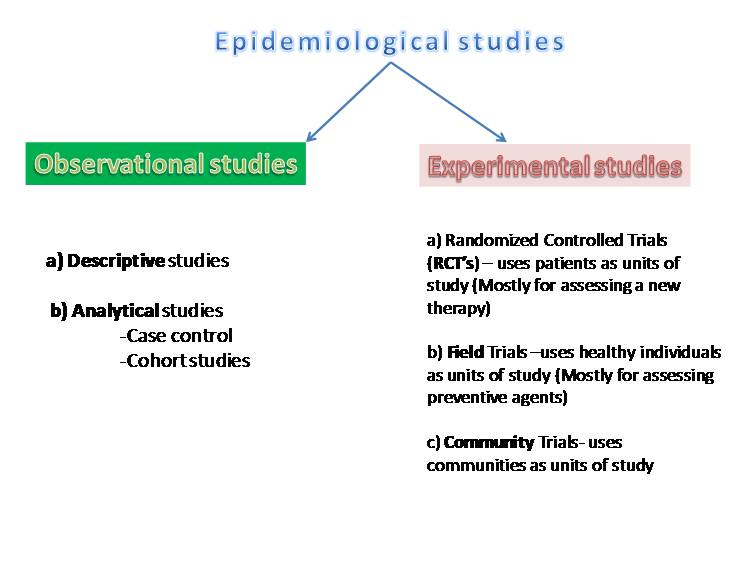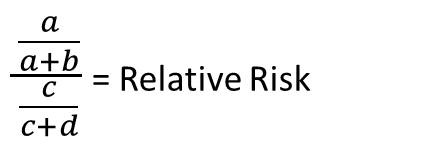
There are two broad types of epidemiological studies:
1. Observational studies – we do not interfere in the process of the disease, but simply observe the disease and the associated factors.
2. Experimental studies – deliberate intervention is made and the effect of such intervention is observed.
Observational studies include:
Descriptive study and
Analytical study – Case control and cohort studies are the two types of analytical observational studies
Experimental studies
There are three main types of experimental studies.
1. Randomized controlled trials (RCT) – uses patients as units of study, mostly for assessing a new therapy
2. Field trials – uses healthy individuals as units of study, mostly for assessing preventive agents like vaccines
3. Community trials – uses communities as units of study for assessing community based interventions like health status in villages with a training program versus in those without
Few lines about each study type
Descriptive study:
• The disease distribution in a community is described in terms of Time, Place and Person.
• This study can give clues about the ‘risk factors’ and the cause
Case – control study:
I. A group of ‘cases’ of a disease is assembled.
II. Another group of matched ‘controls’ (free from disease) is assembled.
III. The history of exposure to the suspected risk factor is ascertained in all the members of both the groups
IV. The prevalence of the exposure among the cases is compared with that in the controls.
V. Factors which are significantly more in the cases group as compared to the control are reaffirmed as the risk factors
-By same argument, factors which are significantly higher in the controls are noted as the possible protective factors.
VI. Odd’s ratio (OR) is calculated in case – control studies to estimate the risk associated with each risk factor

Cohort study:
I. One group of people exposed to the suspected RF is identified.
This is the ‘Exposure cohort’
II. Another group of people similar to the exposure cohort, but DEFINITELY NOT EXPOSED are identified.
– This is the ‘Control or Non-exposed cohort’.
III. The groups are similar except for the ‘exposure’ to the risk factor.
• It is made sure that none of the members in both the groups have the disease under investigation
IV. Both the cohorts are regularly followed up for a definite period and examined for development of the disease at regular intervals
V. If the incidence of the disease is significantly higher in the exposed cohort, the association is confirmed
VI. Relative Risk (RR) is calculated in cohort studies to estimate the risk associated with each risk factor




Experimental study: RCT
• Cases of the disease are identified.
• If eligible, are included in the study after informed consent
• Randomized to allot each case to either the ‘study’ group or the ‘control’ group
• The ‘Control’ group is deliberately exposed to the therapy, vaccine or the suspected RF (study group) while the other is not (control group).
• Both the groups are followed up for under identical circumstances
• The cure rate or the incidence (for therapy or vaccine/RF respectively) in the study group is compared with that in the control group which did not receive the intervention.
• If the difference is significant, the therapy is better or an association is confirmed.
• If not, the drug is considered ineffective
'Blinding' is an instrument to minimize bias in experimental studies
Field Study
• Mainly for vaccines or preventive agents
• Hence units of study are HEALTHY individuals or those without disease
• The incidence among vaccinated is compared with the incidence among non vaccinated
• The two groups i.e. vaccinated and non vaccinated can not usually be decided by randomization
• Hence they may not be exactly comparable
Community Trial
• Some communities e.g. districts may have the public health intervention like a new method of water purification
• Other districts continue with the older methods
• The incidence of water-borne disease can be compared among these districts
The usual sequence of progress from one type of study to the next, as the evidence of an association builds up is as follows:
i. Descriptive study of the disease
ii. Case control study using the diagnosed cases and confirmed controls
iii. Cohort study: using ‘exposed’ and ‘un –exposed’ cohorts
iv. Experimental study: removing the suspected cause in one group of patients and not in another, then observing for the cure in each group
Single blinding:when the patient does not know if he/she is getting the drug or placebo
Double blinding:where the patient and the dispensing doctor also does not know whether the patient is getting the drug or placebo
Triple blinding:where the patient, dispenser and the person analysing the data also does not know the identity of the groups as the ‘therapy’ or ‘placebo’.
References:
Tiwari P. Epidemiology Made Easy. New Delhi: Jaypee Brothers; 2003
Gordis, L. (2014). Epidemiology (Fifth edition.). Philadelphia, PA: Elsevier Saunders.
Bonita, R., Beaglehole, R., Kjellström, T., & World Health Organization. (2006). Basic epidemiology. Geneva: World Health Organization.
Schneider, Dona, Lilienfeld, David E (Eds.), 4th ed. Lilienfeld’s Foundations of Epidemiology. New York: Oxford University Press; 2015
K. Park. Principles of Epidemiology and Epidemiologic Methods. In Park’s Textbook of Preventive and Social Medicine. 24th Ed. Jabalpur: Banarasidas Bhanot, 2017: pg 58 – 145
(adsbygoogle = window.adsbygoogle || []).push({
google_ad_client: "ca-pub-2296304216845141",
enable_page_level_ads: true
});
Steps in Investigation of an Epidemic: http://www.ihatepsm.com/blog/epidemiology-steps-investigation-epidemic
Tests of Significance: http://www.ihatepsm.com/blog/epidemiology-tests-significance
Monitoring and Evaluation: http://www.ihatepsm.com/blog/epidemiology-monitoring-and-evaluation
Advantages and Disadvantages of Case Control Studies: http://www.ihatepsm.com/blog/epidemiology-advantages-and-disadvantages-c...
Advantages and disadvantages of cohort study: http://www.ihatepsm.com/blog/epidemiology-advantages-and-disadvantages-c...
Basic Concepts in Epidemiology: http://www.ihatepsm.com/blog/epidemiology-basic-concepts
Types of Epidemiological Studies: http://www.ihatepsm.com/blog/epidemiology-types-epidemiological-studies
Differences between Case – control and cohort study: http://www.ihatepsm.com/blog/epidemiology-differences-between-case-%E2%8...
Uses of epidemiology: http://www.ihatepsm.com/blog/epidemiology-uses-epidemiology
Blinding in Experimental Studies: http://www.ihatepsm.com/blog/blinding-experimental-studies
Evaluation of a Screening Test: http://www.ihatepsm.com/blog/epidemiology-evaluation-screening-test
